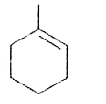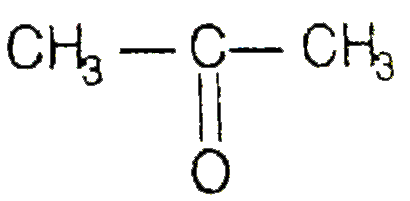HC≡CHDil.H2SO4−−−−−−→+Hg2+CH3CH=0
Which statement(s) is/are correct about the given reaction?
(a) C atom accepting the H is reduced, and the C atom forming a bond with OH is oxidised.
(b) Given reaction is a redox reaction.
(c) The average oxidation number of the two C atoms in each compound is same (−1).
(d) The average oxidation number of the two C atoms in each compound is same (−2). The net effect is no change in average oxidation state.
The correct Answer is:A, C
To analyze the given reaction and determine which statements are correct, we will break down the reaction step by step.
Step 1: Identify the Reaction
The reaction given is:
HC≡CHDil. H2SO4→+Hg2+CH3CH2OH
This indicates that ethyne (HC≡CH) is reacting with dilute sulfuric acid (H₂SO₄) in the presence of mercuric ions (Hg²⁺) to form ethanol (CH₃CH₂OH).
Step 2: Mechanism of the Reaction
1. Formation of Vinyl Alcohol:
- The ethyne undergoes hydration in the presence of H₂SO₄ and Hg²⁺, leading to the formation of vinyl alcohol (CH₂=CHOH).
- This is an initial step where the triple bond is converted to a double bond with the addition of water.
2. Tautomerization:
- Vinyl alcohol is unstable and quickly tautomerizes to form ethanol (CH₃CH₂OH).
Step 3: Oxidation States
To analyze the oxidation states:
- In ethyne (HC≡CH), the carbon atoms are in the -1 oxidation state.
- In ethanol (CH₃CH₂OH), the carbon atoms are in the -1 and 0 oxidation states.
Step 4: Evaluate Statements
1. Statement A: "C atom accepting the H is reduced, C atom forming a bond with OH is oxidized."
- This statement is correct. The carbon that accepts hydrogen (H) is reduced, and the carbon that forms a bond with hydroxyl (OH) is oxidized.
2. Statement B: "The given reaction is redox."
- This statement is incorrect. Although there are changes in oxidation states, the overall reaction does not involve a transfer of electrons typical of redox reactions.
3. Statement C: "The average oxidation number of the two C atoms in each compound is the same, -1."
- This statement is correct. The average oxidation state of carbon in both the reactant and product remains consistent.
4. Statement D: "The average oxidation number of 2 C atoms in each compound is the same, -2, then net effect is no change in average oxidation."
- This statement is incorrect. The average oxidation state changes from -1 in ethyne to -1 and 0 in ethanol.
Conclusion
The correct statements regarding the reaction are:
- Statement A is correct.
- Statement C is correct.
Final Answer
The correct statements about the given reaction are A and C.
---
The reaction given is:
HC≡CHDil. H2SO4→+Hg2+CH3CH2OH
1. Formation of Vinyl Alcohol:
- The ethyne undergoes hydration in the presence of H₂SO₄ and Hg²⁺, leading to the formation of vinyl alcohol (CH₂=CHOH).
- This is an initial step where the triple bond is converted to a double bond with the addition of water.
- Vinyl alcohol is unstable and quickly tautomerizes to form ethanol (CH₃CH₂OH).
To analyze the oxidation states:
- In ethyne (HC≡CH), the carbon atoms are in the -1 oxidation state.
- In ethanol (CH₃CH₂OH), the carbon atoms are in the -1 and 0 oxidation states.
1. Statement A: "C atom accepting the H is reduced, C atom forming a bond with OH is oxidized."
- This statement is correct. The carbon that accepts hydrogen (H) is reduced, and the carbon that forms a bond with hydroxyl (OH) is oxidized.
- This statement is incorrect. Although there are changes in oxidation states, the overall reaction does not involve a transfer of electrons typical of redox reactions.
- This statement is correct. The average oxidation state of carbon in both the reactant and product remains consistent.
- This statement is incorrect. The average oxidation state changes from -1 in ethyne to -1 and 0 in ethanol.
The correct statements regarding the reaction are:
- Statement A is correct.
- Statement C is correct.
The correct statements about the given reaction are A and C.
Topper's Solved these Questions
- ALKYNESBOOK - CENGAGE CHEMISTRY ENGLISHCHAPTER - ALKYNESEXERCISE - Exercises (Single Correct Answers Type)
30 Videos
- ALKYNESBOOK - CENGAGE CHEMISTRY ENGLISHCHAPTER - ALKYNESEXERCISE - Exercises (Archives - Single Correct Answer Type)
6 Videos
- ALKYNESBOOK - CENGAGE CHEMISTRY ENGLISHCHAPTER - ALKYNESEXERCISE - Exercises (Linked Comprehension Type)
51 Videos
- ALKENES AND ALKADIENESBOOK - CENGAGE CHEMISTRY ENGLISHCHAPTER - ALKENES AND ALKADIENESEXERCISE - Single correct Answer
14 Videos
- APPENDIX - INORGANIC VOLUME 1BOOK - CENGAGE CHEMISTRY ENGLISHCHAPTER - APPENDIX - INORGANIC VOLUME 1EXERCISE - chapter-7 Single correct answer
1 Videos
Similar Questions
Knowledge Check
H3C−C≡CHHg+2/H2SO4−−−−−−−−→XKMnO4−−−−→Y :
AX is H3C−OH∣C=CH2BX is H3C−O∣∣C−CH3CY is H3C−O∣∣C−OHDY is HCOOHADil. H2SO4/Hg2+−−−−−−−−−−−→ 1 - Methylcyclohexanol. Here A is :
A B
B C
C Da or b
Da or bH−C=C−HHgSO4−−−→H2SO4(A)(1)NH3+HCN−−−−−−−−−→(2)H3O⊕(B), Product (B) of given reaction is :
AGlycineBAlanineCvalineDLeucine
Consider the following reaction sequence,
CH3C≡CHaq.H2SO4−−−−−→HgSO4APCl5−−→HeatB
The products (A) and (B) are, respectively,
View SolutionCH3−C≡CH40%H2SO4−−−−−−→1%HgSO4Aisomerisation−−−−−−−→

Structure of A and type of isomerism in the above reaction respectively are
View SolutionCH=CHHgSO4−−−→H2SO4XLiAlH4−−−→Y.
In the above reaction, X and Y are
View SolutionCH3−C≡CHHgSO4−−−−−−−→dil.H2SO4 product
Product of the above reaction is
View SolutionS+HNO3(Dil.)→H2SO4+No↑⏐
View Solution
